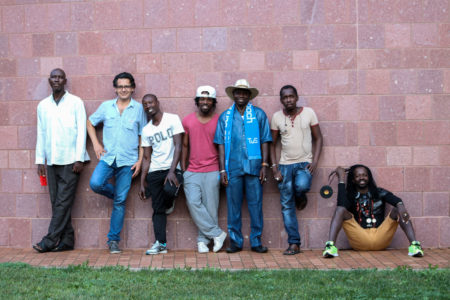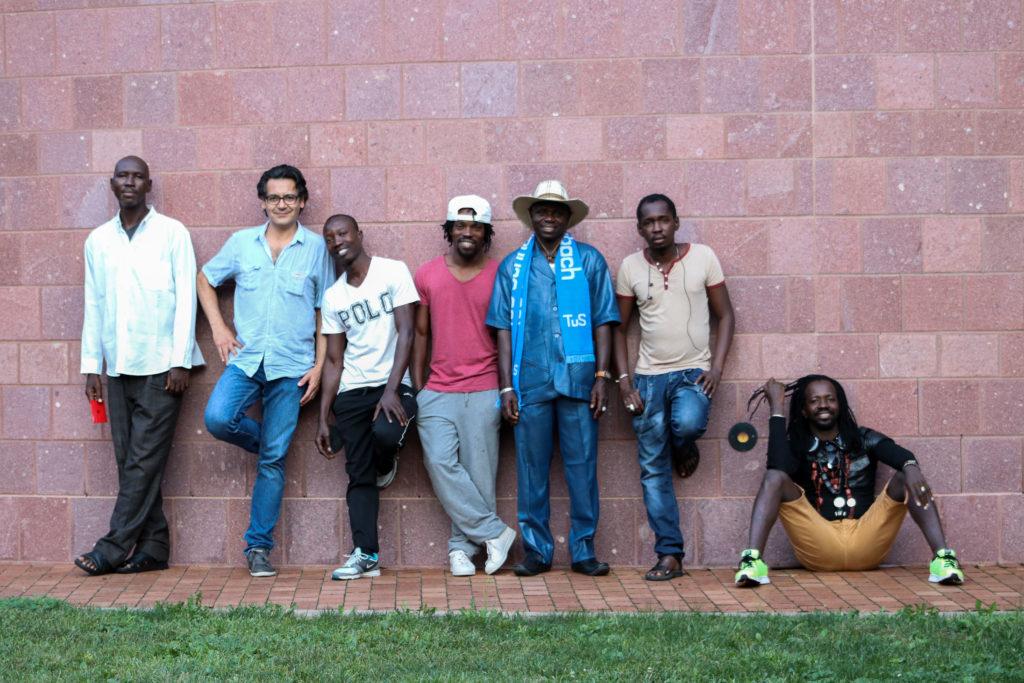By Caryn McKechnie
mchechni@grinnell.edu
The lights dimmed, prompting the audience’s muttering and shuffling to cease. Among the audience, I awaited the start of “Declassified Memory Fragment,” suspended in the silence and the darkness. Three panels at the back of the Flanagan Theater were then illuminated, showing the silhouette of a man on his knees with a coat draped over his head.
The performance consisted of a sequence of disparate scenes, from a motorcycle ride to a nightclub. Occasionally, the dancers spoke lines in French. I struggled to discern a clear cut narrative, as the dance presented itself in fragments. The performance pulled me in with its unique dance style and the questions it raised.
I had the opportunity to talk with members of the Baker and Tarpaga Dance Project about the origins of their dance group and the symbolism in their performance. Many of the performers spoke only French, so the conversation consisted of a melee of French and English. The dancers are all from Burkina Faso, a landlocked country in West Africa.
“Everybody is a proficient musician, artist and choreographer here, and we know each other very well. We all come from same country, even state, so when Olivier was thinking about this project, he started making contact with each person to [bring us together]” said Aguibou Bougobali Sanou, a member of the group. They have danced together for the last five years, Sanou said.
Sanou discussed the group’s utilization of symbolism in their pieces.
“The pieces speak about the politics of Africa. … Many people do not accept the president because the president is not okay for this generation,” Sanou told me.
Cyril Givort elaborated on this point, unpacking a scene in which two men fought over one coat.
“At first, when we started this project, it was at the time of the presidential election in Kenya. There were two candidates, and one wins the elections, and he asked the other one to be his first minister. Then, there are two people trying to have the same jacket, to have peace.”
“Olivier used the jacket to show two persons sharing the power of the president’s chair, but it is not possible, only one person can have the power,” Sanou added, critiquing this model, which is a trend along the Ivory Coast.
Aziz Derme chimed in, describing how the dance crew visualized their choreography.
“We work with pictures. For example, in the beginning, we have three people on a motorcycle. This one is a picture to explain the road in the morning. You have the person with the motor who can take his wife, his children — many people — on the motor in the morning in Ouagadougou, for example,” he explained.
The Baker and Tarpaga Dance Project not only performed in the Flanagan theater, but visited multiple dance classes, including Celeste Miller’s Movement for the Performer and Contemporary Dance in a Global Context. In an email to The S&B, Miller commented on the dance style and choreography,
“Olivier expressed that it was a hybrid of the many trainings the dancers bring — West African traditional forms, ballet and contemporary as well as yoga and capoeira. [Olivier] talked about the difference between ‘fusion’ and his approach of building a ‘hybrid’ technique,” Miller wrote.
Miller also commented on themes and structure.
“I found myself transported to images from a part of the world I don’t know, but the range of inhumanity to humanity is a tale told around the world. The work had a sequential narrative unfolding that began with a motorcycle ride through town, to images of bullying and abuse of power, to the devastation of betrayal, and concluding with fellowship with one another,” she said. “I found the performance to be a rich example of what the excellence of political work can look like.”
The dancers also made a special appearance in Professor Kathleen Hurley’s class, Introduction to Dance.
Hurley remarked, “Nebie Adonis said the dance, for him, is about the politics and protests going on in Burkina Faso. He said he cannot do dance such as the USA television show ‘America’s Got Talent’ or ‘So You Think You Can Dance’ — not because he lacks the talent — but because his dance is about life’s deepest needs,” Hurley said. “He cannot do dance where you are entertaining or joking around. He dances like his life depends on it. Adonis and Aziz both said it is easier to get a Coca-Cola in their country than to have a clean drink of water and that is not right. Politicians drive big fancy cars, but there are not good roads for the average person to drive on. They use the art form of dance as a communicator for their social justice issues.”
The Baker and Tarpaga Dance Project is currently on a five week tour of the U.S., having won a National Dance Project Production Grant. After Grinnell, they will perform at various colleges, including Princeton University and Middlebury College, before returning home.
Baker and Tarpaga Dance Project showed us how dance can function as a political art form, as well as gave us a glimpse into their happiness and criticisms with the political and cultural climate of some African countries, such as Burkina Faso, their home.

Photo by Mahira Faran





























































